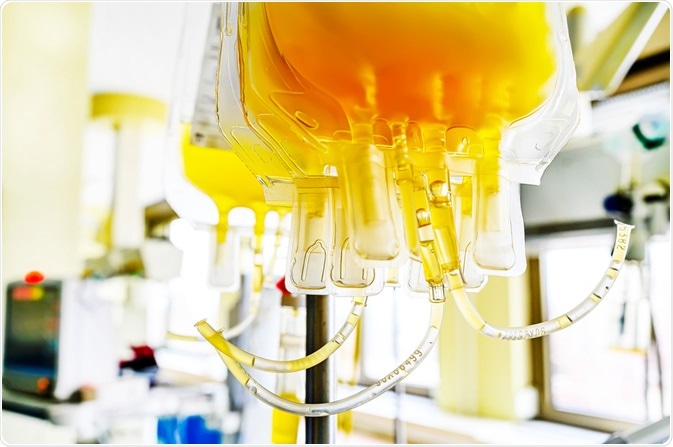Why study human plasma?
Human plasma, which is the liquid that carries blood cells and platelets, is highly rich in various proteins that circulate around the human body. This collection of proteins is known as the “proteome”, and in this case, it is the “plasma proteome”.
Plasma is easily collected from an individual for study, and may also contain proteins that were released from cells due to disease. Plasma is, therefore, a good starting point to study markers that may be indicative of diseases, and thus may lead to the identification of novel treatment targets. These include markers that are indicative of disease risk, disease presence, or disease progression.

Blood Plasma. Image Credit: pirke/Shutterstock.com
Common techniques used to study the proteome
Mass Spectrometry
Mass spectrometry uses the mass-to-charge (m/z) ratio of a particle to determine its molecular structure and can be applied to proteins and amino acids. Therefore, this can be used to study proteomes, including the plasma proteome. This can be carried out in different ways. One such method involves digesting the proteins, before running them through liquid chromatography apparatus and finally through a mass spectrometer, providing high sensitivity.
Alternatively, intact proteins are put through the mass spectrometer. this would not only identify protein but also identify post-translational modifications.
A combination of the two strategies can be adopted, where the proteins are fragmented to a lesser degree, thus allowing for some post-translational modifications to be maintained while overcoming the difficulties in charging and separating intact proteins.
Affinity Reagent Arrays
Arrays consist of a solid surface coated with “probes”, which can be proteins or DNA, among other compounds. There are two alternative techniques for this: in one technique “forward-phase protein array”, probes are spotted onto the solid surface and the analyte is applied over the array. In the second technique, the samples are spotted onto the solid surface and the probes are then put over the array, allowing for multiple samples to be analyzed at once.
What can we learn from studying the plasma proteome?
Cancer
Cancer is a leading cause of mortality worldwide, and studies in the past have revealed much about how tumors progress. This progression can be broken down into basic steps: break-through, expansion, and invasion, and each of these is accompanied by specific genomic mutations.
The early detection of cancer generally leads to a better treatment outcome and prognosis, so it is beneficial to be able to diagnose cancers at an early stage. Therefore, plasma proteomic studies for cancer have focused on identifying such markers.
Cardiovascular Disease
Cardiovascular diseases not only cover diseases of the heart but also of the blood vessels. To support the diagnosis of cardiovascular disease, plasma biomarkers can be used: Brain natriuretic peptide (BNP) is a hormone released from the ventricle of the heart during stress and is, therefore, an indication of congestive heart failure.
Troponin T and troponin I have forms that are specifically found in the myocardium, and the presence of these forms of troponin T and troponin I indicate injury to the myocardium, which can occur during myocardial infarction or a heart attack. These markers are used for diagnosis, and in the case of BNP also as a prognostic marker. Highly sensitive assays have shown that there is a possibility for these to be used as a risk indicator as well.
Further Reading
Last Updated: Feb 1, 2021